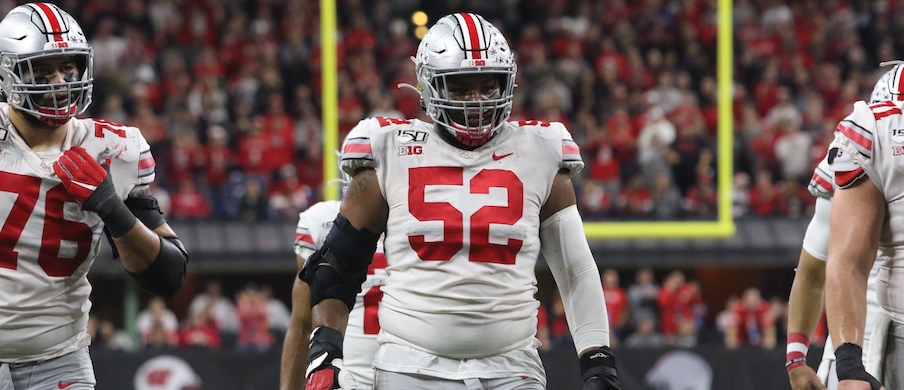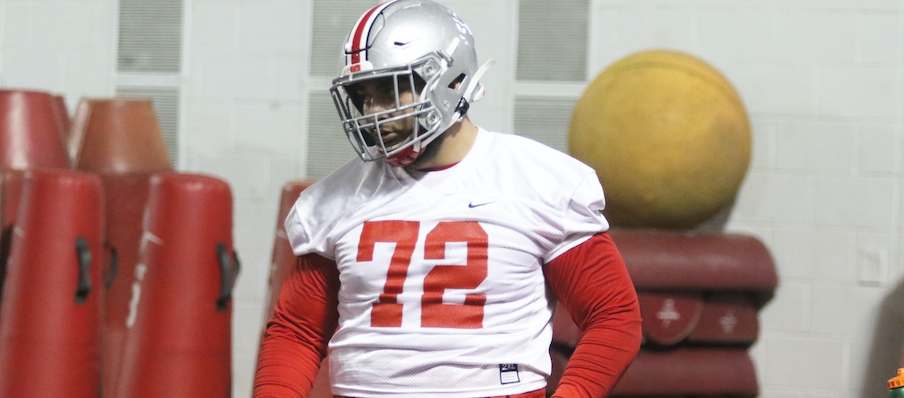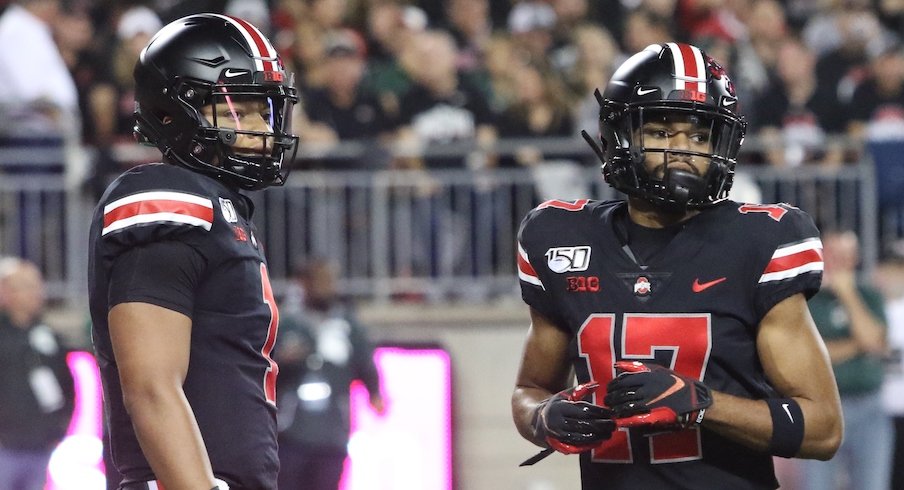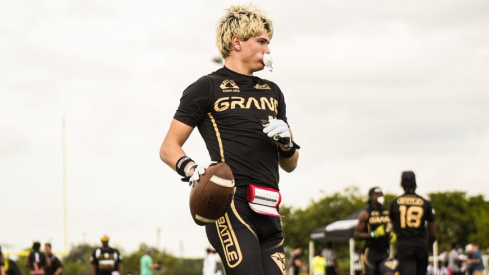In April, no matter if and when the Big Ten eventually sets up to play its upcoming season, plenty of Ohio State players will take off for the 2021 NFL Draft.
It’s an annual tradition at this point to lose a slew of high-impact players who go pro, and led by Justin Fields and Shaun Wade, it’ll happen again in the spring regardless of when the Buckeyes next suit up to play football. But, how will the upcoming season – or the potential lack of – affect each of Ohio State’s draft prospects?
That’s the question we’re focusing on today since many of their futures in Columbus remain in the balance, and because the Big Ten hasn’t announced the start date to its upcoming season, it’s possible – or even likely – that some of the Buckeyes won’t play. Concerns about the coronavirus and whether or not to play college football during a pandemic is a smart decision will naturally factor into the minds of players, but we’re simply looking at how one more season at Ohio State would help their draft stocks.
Justin Fields (QB)
How the NFL currently views him: Fields is a first-round lock who’s expected to be a top-10 draft pick, with many projecting him to be among the first three players selected. ESPN’s Mel Kiper Jr. views him as the No. 3 overall player, The Athletic’s Dane Brugler has him as the No. 7 player and Bleacher Report’s Matt Miller sees him going to the Carolina Panthers with the No. 4 overall selection.
How a season could impact his draft stock: If Fields wants a chance to go No. 1 overall in the 2021 NFL Draft, he would likely have to set foot on the field once more for Ohio State. Right now, while most see him as a top-10 pick, he’s vying to become the top quarterback with Clemson’s Trevor Lawrence and North Dakota State’s Trey Lance. It’s hard – though not impossible – to see him getting picked ahead of both of them as a one-year starter who doesn’t play in 2020 when the others do, even if in Lance’s case it’s just one game.
Now, would that be enough motivation for him to decide to suit up for the Buckeyes again? Perhaps. However, whether or not they’ll have a chance to play for a national title – in other words, whether or not they can push through a season starting in October – might be a bigger factor for the star quarterback. Since he’ll want to be prepared to play a full 2021 season in the NFL, the upcoming season’s yet-to-be-determined start date should play a significant role in whether Fields plays and takes aim at becoming the No. 1 overall draft pick.
Shaun Wade (CB)
How the NFL currently views him: Wade is projected by almost everyone as a first-round selection, with his value by draft analysts climbing as high as a top-10 pick. ESPN’s Mel Kiper Jr. ranks him as the No. 7 overall player, The Athletic’s Dane Brugler has him at No. 16 overall and Bleacher Report’s Matt Miller has him going at No. 18 to the Tennessee Titans in his latest mock draft.
How a season could impact his draft stock: Wade would have a chance to go from being a middle-of-the-first-round cornerback to becoming the top-rated player at his position if he plays another season at Ohio State. But also, similarly to Fields, his draft stock would likely remain steady should he sit out, which appears to be the most likely option if the Big Ten sets a schedule beginning any time after October.
Because he’s planning a move from nickelback to cornerback, Wade was looking forward to proving he can line up against No. 1 wide receivers and have success on the outside. Alas, unless the Big Ten gets a schedule together quickly, he might have to wait to show that skill off in the NFL since just about every draft analyst already projects him as a first-rounder.
Chris Olave (WR)
How the NFL currently views him: As of now, most analysts have him on the first-round/second-round bubble. He’s not a surefire first-rounder. ESPN’s Mel Kiper Jr. doesn’t rank him in his top 25 but sees him as the fifth-best wide receiver in the draft class, The Athletic’s Dane Brugler rates him as the No. 33 overall player and Bleacher Report’s Matt Miller predicts he gets picked No. 29 overall by the New Orleans Saints.
How a season could impact his draft stock: Olave’s already in an optimal spot as a wide receiver who could get taken as a first-rounder regardless of whether or not he plays again for Ohio State. One more season as a Buckeye would give him an opportunity to solidify himself as a first-round pick rather than reside on the first-round/second-round bubble.
How much higher Olave’s stock could get, though, is up for debate. He doesn’t profile as a typical top-of-the-first-round wideout, yet perhaps he could show another level with a second year of catching passes from Fields and a third year of getting coached by Brian Hartline.

Wyatt Davis (OG)
How the NFL currently views him: Davis is another Buckeye on the precipice of the first round whose spot among the first 32 players picked isn’t secure. ESPN’s Mel Kiper Jr. did not include him within his top-25 players but ranks him as the No. 1 offensive guard, The Athletic’s Dane Brugler sees him as the No. 19 overall player in the class and Bleacher Report’s Matt Miller has him going No. 32 overall to the Kansas City Chiefs.
How a season could impact his draft stock: Davis is in an interesting spot since most analysts either have him as a late first-round pick or an early second-round pick. Provided he suits up for the Buckeyes again, he’d get a chance to secure his spot as the top-rated guard in his class, which could push him slightly up in the overall rankings – though it’s worth noting that the NFL draft ceiling for most guards isn’t as high as it is at most other positions.
But, what would happen if he chooses to sit out? He’s only a one-year starter, and while people already see him as the 2021 draft class’ No. 1 guard, it’s worth wondering whether or not he’d hang onto that status if he doesn’t play college football again. Game experience is viewed as especially important for offensive linemen, which could factor into Davis’ decision. Either way, his stock is in a good position right now.
Josh Myers (C)
How the NFL currently views him: The wide range of views begins with Myers, who’s seen as possibly going anywhere from the second round to fourth round. ESPN’s Mel Kiper Jr. slots him in as the No. 3 center in the draft, The Athletic’s Dane Brugler ranks him as the No. 39 overall player and Bleacher Report’s Matt Miller didn’t include him at all in his three-round mock draft.
How a season could impact his draft stock: The situation with Myers mirrors much of what Davis will have to consider, except he’s lower on early draft analysts’ boards than his right guard counterpart. One more season as a Buckeye could take him from being a mid-round pick to an early-round pick, which is part of the reason why he returned to school for a redshirt junior season.
Myers has only one year of experience as a starting center, meaning NFL teams could benefit from seeing him once more at Ohio State. He’s already viewed as one of the three top centers in the draft. Yet in order to become the first center selected, he’d likely have to play one more season.
Pete Werner (LB)
How the NFL currently views him: Mostly viewed as a mid-round selection right now, Werner doesn’t appear on most analysts’ projections. Neither ESPN’s Mel Kiper Jr. nor The Athletic’s Dane Brugler mention him, though Bleacher Report’s Matt Miller has him getting taken in the third round at No. 67 overall in his three-round mock draft.
How a season could impact his draft stock: Because of the linebacker unit’s failures in 2018, Werner still wrongly gets lumped in as an unproductive player. Based on him being arguably the team’s best linebacker in 2019, that’s an egregious opinion, but you still hear it sometimes. Werner could further distance himself from an up-and-down sophomore year by thriving in a third season as a starter.
Werner’s seen as a mid-round pick at the moment, though a strong final year could shoot him up to early-round consideration. His skillset, which includes the ability to cover several positions and line up all over the field, is coveted by NFL teams.
Tommy Togiai (DT)
How the NFL currently views him: Like Werner, Togiai is seen as a possible mid-to-late-round pick right now. While ESPN’s Mel Kiper Jr. and The Athletic’s Dane Brugler don’t reference him, Bleacher Report’s Matt Miller sees him as getting picked in the third round at No. 72 overall by the Las Vegas Raiders.
How a season could impact his draft stock: Maybe more than anybody else on this list, Togiai was primed to take a leap in his development in 2020. He served as a backup as a freshman, then he played 250 snaps as a rotational nose tackle his sophomore year. As a junior, he was penciled in as Larry Johnson’s sole starter in the middle of the defensive line.
Long regarded as Ohio State’s strongest player, Togiai has the ability to end up as a high draft pick. He needs at least one more season as a Buckeye to reach those heights.

Baron Browning (LB)
How the NFL currently views him: A possible mid-to-late-round pick, Browning’s name doesn’t come up in analysis by The Athletic’s Dane Brugler or Bleacher Report’s Matt Miller. He is, however, viewed as the No. 4 inside linebacker in the class by ESPN’s Mel Kiper Jr.
How a season could impact his draft stock: A former five-star linebacker, Browning should have the talent to get picked early in the NFL draft. But so far, he hasn’t even been a full-time starter. With Malik Harrison gone to the Baltimore Ravens, Browning’s projected to start at weakside linebacker for the Buckeyes.
If he can finally live up to his lofty potential, Browning’s physicality and athleticism from a 6-foot-3, 240-pounder with ample pass-rushing skills could make him a high-round selection. There’s a lot for him still to prove in one more year at Ohio State.
Trey Sermon (RB)
How the NFL currently views him: The transfer running back is a likely mid-to-late-round pick who’s not usually appearing in most projections or mock drafts as of now.
How a season could impact his draft stock: Considering Sermon opted to graduate transfer from Oklahoma to Ohio State after his third collegiate season rather than test the NFL waters, it’s fair to assume that he feels he needs one more year in college to show out. The chance to play a 2020 season is as important to him as anybody else on this list.
Sermon rushed 54 times for 385 yards in an injury-shortened junior season before transferring, and he needs to prove that he’s both healthy and productive for his stock to rise.
Thayer Munford (OT)
How the NFL currently views him: Munford doesn’t appear in mock projections or mock drafts right now.
How a season could impact his draft stock: Though Munford has already started each of the past two seasons at left tackle, he needed a bit of a prove-it year where he showed he could both stay healthy and play with a greater degree of consistency – especially when he’s banged up. He’s talented enough to jump up into early-round or mid-round discussions, but because of his injury issues the previous two seasons and stints when he struggled at times to move as well as he likes, he’s not there yet.
If Munford can manage to make it through fully healthy, one more season as a Buckeye could propel him. Or, of course, nagging injuries might strike again and would continue to hinder his NFL draft prospects.
Others of note
- Luke Farrell (TE): In a sense, Farrell is everything Ohio State wants in a tight end. He’s reliable, a quality blocker, a quiet leader by example, doesn’t ask for touches and is a competent receiver when targeted. His NFL draft stock also likely won’t rise or fall much at all based on how he plays in one more season. He is who he is, and that’s a productive college tight end who has a chance for a multi-year NFL career.
- Jeremy Ruckert (TE): Some people have wondered whether or not Ruckert would jump to the NFL even though he’s not on most NFL draft analysts’ radars. In order to make that a reality, the tight end would likely need a significant step forward in production after 14 catches for 142 yards and four touchdowns in 2019. The upcoming season will either propel him up draft boards or, more likely, cause him to stick around for another season.
- Jonathon Cooper (DE): As of now, though Cooper has earned a well-deserved reputation as one of the team’s leaders, the returning team captain is still searching for his on-field breakout season. He anticipated it coming last year as a senior, though an ankle injury ensured it wouldn’t happen. Cooper, who hasn’t recorded more than 2.5 sacks in a season, undoubtedly needs a standout year to get on NFL radars in a bigger way. No matter when the season gets played, much will be on the line for him.
- Josh Proctor (S): Is it weird to put a safety on this list who hasn’t served as a full-time starter before? Maybe, but Malik Hooker walked that path before. Proctor has all the physical talent anybody has ever asked for in a safety, so if he can put it all together, it’s not difficult to envision him shooting up NFL draft boards. The question for him is whether he’s able to make such a rise in the upcoming season or whether he’ll need a couple of years in Columbus as a starter.
- Sevyn Banks/Cameron Brown (CB): Might as well group these two together since they’re in the same situation as third-year cornerbacks in line to become first-year starters whenever this season commences. Banks has long been touted as a possible future high-round NFL draft pick, and Brown’s top-end athleticism will eventually be coveted by teams at the next level. It remains to be seen, however, whether one season – especially if it’s shortened – will be enough for either of them to become a serious prospect for the 2021 draft.
- Tyreke Smith (DE): At one point in time, many people likely saw Smith as a three-and-done Buckeye defensive end. Instead, after a three-sack season that included him battling injuries, he’s not a highly-discussed NFL draft prospect. A huge junior season could change that, propelling him to leave Ohio State. Yet it’d need to be a true breakthrough for him to consider it strongly.
- Tuf Borland (LB): The world sort of knows what to expect from Borland at this point. He’s a smart, physical, two-down middle linebacker who lacks the speed and athleticism to succeed on passing downs in the NFL. While he’s back for a redshirt senior season, this upcoming season perhaps matters less to Borland's draft stock than anyone else on this list.
- Justin Hilliard (LB): Injury concerns will follow Hilliard to the NFL, provided he leaves for the next level following the upcoming Ohio State season. But the sixth-year senior legitimately could get himself drafted if he’s able to secure a regular spot in Al Washington’s rotation or, perhaps, if Werner moves to Will – or chooses to focus on the NFL and bypass this season – which would subsequently open up a spot for Hilliard at Sam.
- Drue Chrisman (P): Based on sheer numbers, nobody should bet on an NFL team actually drafting Chrisman. Somewhere between zero and four punters have been picked in each of the past three decades of drafts. Chrisman likely needs to have a monstrous next season to earn a spot as a draftee.


